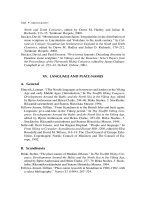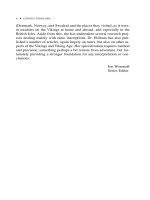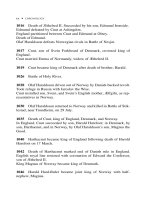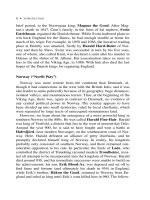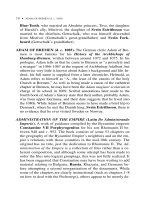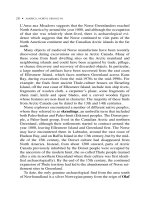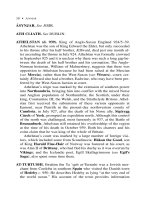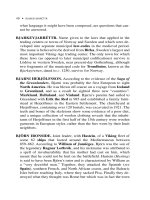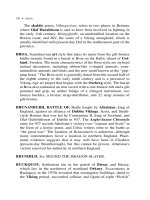The A to Z of the Vikings 17 ppsx
Bạn đang xem bản rút gọn của tài liệu. Xem và tải ngay bản đầy đủ của tài liệu tại đây (65.16 KB, 10 trang )
clutch both ends of the hogback. Some hogbacks, such as the so-
called Giant’s Grave from Penrith in Cumbria, appear to have been
part of larger monumental arrangements involving hogbacks and
crosses. The vast majority of the hogbacks seem, from their orna-
mentation, to date to the period c. 925–1000, although the example
from Brechin, Tayside, Scotland has 11th-century features.
The distribution of the hogbacks is largely confined to northern
England, with notable centers at Brompton and Lythe in North York-
shire and Sockburn-on-Tees in County Durham. There is, however, a
group of hogbacks from central Scotland, including a group of five
from Govan (Glasgow), and single examples from Wales and Ire-
land. There are no Scandinavian hogbacks, and it appears that the
monument may represent an adaptation of solid stone shrines known
from the British Isles. The distribution of the hogbacks in northern
England largely coincides with the distribution of Norwegian or
Gaelic-Norse place-names, suggesting that Irish influence may be
linked to the development of this “colonial” form of monument.
HOLMGÁRD
–
R. See NOVGOROD.
HOLY RIVER, BATTLE OF. Battle fought in 1026 in the province
of Skåne in the southwest of present-day Sweden. Cnut I the Great
was defeated in this battle by a Swedo-Norwegian alliance, led by
King Anund Jakob of Sweden and King Olaf Haraldsson of Nor-
way. An account of the battle, containing skaldic verse composed
for Cnut by Óttar the Black and Sighvatr
þþ
ór
ðð
arson, is preserved
in Snorri’s Heimskringla. The Anglo-Saxon Chronicle also men-
tions Cnut’s defeat in an entry for 1025, although it names his op-
ponents as Ulf and Eilaf. Earl Ulf was probably Cnut’s brother-in-
law (and the uncle of Harold Godwinsson, future king of England)
and is described as Cnut’s “protector” of the Danish kingdom; he
apparently championed the cause of Cnut’s son, Harthacnut, in
Denmark, and was frustrated by Cnut’s long absences from Den-
mark. Eilaf may have been Ulf’s brother. Saxo Grammaticus’s ac-
count of the battle mentions a triple alliance between the Swedish
and Norwegian kings and Earl Ulf. Despite Cnut’s defeat, he was
able to drive Olaf Haraldsson out of Norway and into exile just two
years later.
138 • HOLMGÁRD
–
R
HON HOARD. The Hon hoard is the largest Viking-Age gold hoard
known from Scandinavia. It was discovered in a bog at Hon in
Buskerud, Norway, during the 19th century, where it was probably
deposited during the second half of the ninth century. The metalwork
is of the highest quality and includes a gold trefoil brooch of Car-
olingian workmanship; a number of gold neck, arm, and finger rings
of mixed provenance (including Russian and Anglo-Saxon pieces);
several gold pendants inset with semiprecious stones; over 100 glass
beads; and 20 gold or silver coins, all of which have had loops added
to them for suspension. Very few of the objects are of Scandinavian
workmanship. On the basis of the coins and the composition of the
hoard, it has been suggested that this was part of the heavy ransom
paid to Vikings in France for the return of Abbot Louis of St. Denis
and his brother in 858.
HORIK. There were in fact two ninth-century kings of Denmark called
Horik, generally known as Horik I the Older (d. 854) and Horik II the
Younger (d. 864–873). Horik the Older was the son of the Danish
king, Godfred, and according to the Royal Frankish Annals, he and
three of his brothers seized power in 813, driving out Harald Klak.
Frankish support for Harald Klak led to a brief period of shared
power c. 819–826, but Horik forced Harald into exile once again in
826/7. By the 830s, all of Horik’s brothers seem to have been dead,
and Horik himself had come to some kind of agreement with the
Frankish emperor, Louis the Pious. However, following Louis’s
death and the resulting battle for power between his sons, Horik
sacked Hamburg and ignored Frankish demands to stop his subjects
from raiding in Frankia. Horik apparently allowed the German mis-
sionary, Ansgar, to build churches in Hedeby and Ribe during the
850s. Around the year 850, he was forced to share the rule of his
kingdom with two nephews. A third nephew, Guthorm (Gudurm), ar-
rived in Denmark in 854, triggering a civil war between Horik and his
nephews and resulting in Horik’s death.
Little is known about Horik II the Younger, although in the An-
nals of Fulda he is described as a “small boy” and the only mem-
ber of the royal family to have survived the civil war. He apparently
refused to be baptized, but allowed missionary work to continue in
his kingdom and sent gifts to Pope Nicholas II in 864. There is no
HORIK • 139
further information about Horik II after this, and very little is
known about conditions in Denmark in general for much of the fol-
lowing century.
HOUSECARL (ON húskarl plural húskarlar). Name given to the
household troops of the kings in England from 1016–1066 and, in
the late 12th-century, it is found in the Danish Vederlov “Law of the
Hird,” which claims to go back to legal provisions made by Cnut I
the Great. The earliest evidence for the use of the term comes from
an account of the translation of the relics of Ælfheah of Canterbury in
1023. This late 11th-century account, by Osbern of Canterbury,
records how the household troops (“called housecarls in the Danish
tongue”) of Cnut created disturbances to distract people’s attention,
guarded key points on the route the relics were transported, and ac-
companied the body itself in case there was any attempt to stop its
movement from London to Canterbury. Harthacnut apparently used
his housecarls to collect taxes in 1041, and when two were killed in
Worcester, he sent an army and “almost all his housecarls” to punish
the town. However, while it used to be believed that the housecarls
performed a purely military role in the households of Cnut, Harthac-
nut, Edward the Confessor (d. 1065), and Harold Godwinsson
(d. 1066), recent work has emphasized the nonmilitary contexts in
which many housecarls appear. As well as collecting tax for Harthac-
nut, a number of housecarls, such as Bovi and Urk, appear in charters
as both witnesses and as recipients of land grants. In Domesday Book,
some people are described as both housecarls and thegns in different
parts of the text, and both Bovi and Urk were also described as thegns
(ministri). This evidence suggests that the housecarls were not a stand-
ing army of mercenaries but rather a group of retainers that followed
and supported the king at court and in the countryside.
HOUSES. The houses built and inhabited by the Vikings varied across
the Viking world, according to climate, available building materials,
and function. The most common kind of house was a rectangular
structure (often with curved side walls), which might measure some
5 to 7 meters in width and between 15 and 75 meters in length, de-
pending on the status and wealth of the householder. This kind of
dwelling is known as a longhouse and usually consisted of one main
140 • HOUSECARL
living room where all the inhabitants ate and slept and where house-
hold tasks such as cooking and weaving were performed. The two
long walls of this room were generally lined with wall benches, built
up with earth and lined with wood, upon which people sat, ate, and
slept. Under the same roof, in rural communities, there was also a
separate cattle byre (although toward the end of the Viking Age, ani-
mal houses and living quarters were often in separate buildings), and
there may also have been a small room for storing foods and other
goods. The longhouse was heated by a long hearth in the middle of
the room, and smoke escaped from a small hole in the roof of the
longhouse. Lighting was supplied by the fire, oil lamps (using herring
or seal oil), and later on by wax candles. There were often no win-
dows in the longhouse, although there might be some very small
holes left in the walls, covered by a translucent material such as thin,
scraped, and stretched animal skin, that let in a little light. The two
exterior doors (to the byre and the main hall) were placed so as to
minimize draughts, depending on the direction of the prevailing
winds. The main longhouse might be surrounded by several separate
buildings with specialized functions, such as a smithy, a dairy, ser-
vants’ quarters, shelter for small animals, and a bathhouse.
In Sweden and Norway, where timber was in plentiful supply,
these longhouses were generally of a solid blockhouse construction
(horizontal logs with overlapping corners), using pine, and with a
birch-bark and turf roof. However, in Denmark, where the climate
was milder and where there was less timber, the walls of houses were
frequently of wattle construction—clay plaster put on to a framework
of upright wooden (usually oak) posts—with a roof of reeds or
thatch. A reconstruction of a wattle-and-daub house from Hedeby
can be found at the Moesgård Museum, near Århus in Denmark. In
largely treeless Iceland, houses were built from turf, earth and stone,
often partially sunken for insulation, and with walls measuring a me-
ter or more in thickness. The Stöng farmhouse, preserved in volcanic
debris, is a good illustration of an Icelandic longhouse.
HRÓLFR KRAKI, SAGA OF (ON Hrólfs saga kraka). One of the so-
called Sagas of Ancient Times. It survives in some 44 manuscripts, the
earliest of which dates to the 17th century. However, it is believed that
the saga was probably composed in Iceland around 1400. Certainly,
HRÓLFR KRAKI, SAGA OF
• 141
the Icelandic monastic library of Möðruvellir lists this saga among its
collections in 1461. Snorri Sturluson refers to tales about Hrólfr in his
Skáldskaparmál and Saxo Grammaticus also describes the exploits
of Hrólfr in his translation of Bjárkamál, which suggests that stories
about this heroic Danish king were popular well before 1461. Indeed,
another reference to the king comes from the Book of Settlements
where Hrólfr’s sword, Skofnung, with which he was buried, is said to
have been stolen by Skeggi of Midfjörd before he settled in Iceland. It
was apparently passed down in the family until one of Skeggi’s de-
scendants, Gellir (d. c. 1073), was buried with the sword at Roskilde,
near Lejre, in Denmark.
Hrólfr was king of Denmark in the sixth century, of the legendary
Skjolding dynasty, with his seat at Lejre in Jutland. His nickname,
kraki “pole-ladder,” was derived from his stature, which was said to
be tall, slim, and like a pole-ladder. The saga includes stories about
Hrólfr’s 12 champions and their role in Hrólfr’s conflict with the
Swedish king, Adils, which eventually brought about their and
Hrólfr’s death in battle. However, much of the material of the saga is
clearly mythical and magical, and the saga narrative is constructed
around sorcerers, trolls, elves, berserkers, and spells.
HRYNHENT (“accentuated verse”). Form of meter used in skaldic
poetry. Hrynhent was the most important meter after dróttkvætt,
and was particularly popular in the 14th century. Hrynhenda, com-
posed by Arnórr
þþ
ór
ðð
arson jarlaskáld, is the first surviving praise
poem in hrynhent and is actually named after the meter. It was com-
posed in the mid-11th century in honor of Magnus the Good Olafs-
son of Norway.
HUGIN (ON Huginn “thought”). One of Odin’s two ravens, the
other being Munin (ON Muninn “the thought”). Hugin appears in
the written sources, such as the Poetic Edda and skaldic verse,
more frequently than Munin. In skaldic verse, the names Hugin
and Munin are used to refer to ravens in general, usually in the
context of battlefields where the fallen warriors are described as
food for ravens. Odin was the god of warfare and the battlefield,
and his ravens were the birds of the battlefield. Perhaps the most
well-known reference to Hugin (and Munin) is in Snorri’s
142 • HRYNHENT
Gylfaginning, where it is said that the two birds fly around the
world every morning, collecting information, and then fly back
and sit on Odin’s shoulders, whispering all that they have heard
and seen. Ravens also appear to have been a popular motif for war
banners: for example, Orkneyinga Saga (ch. 12) refers to a magic
banner made for Earl Sigurd the Stout by his mother, which
brought him victory.
HUMBER, RIVER. Major estuary in northeast England, which formed
an important dividing line between the Anglo-Saxon kingdoms of
Northumbria and Lindsey (northern Lincolnshire). Northumbria is
derived from the OE nor
ð
(an)hymbre “the people living to the north
of the Humber;” and the word, su
ð
hymbri “the people living to the
south of the Humber,” is also found in, for example, the Anglo-Saxon
Chronicle, where on two occasions (s. a. 697, 702) it appears to refer
to Mercia. The annal for 827, however, talks of King Ecgberht’s con-
quest of Mercia and “all that was south of the Humber.”
The Humber was an important sea-route for Viking invaders and
traders, connecting as it did with the Rivers Ouse and Trent. This al-
lowed the Vikings to sail their ships up river to the Northumbrian
capital, York, and down through the East Midlands to Nottingham,
one of the so-called Five Boroughs. The Anglo-Saxon Chronicle
mentions the Humber on eight occasions between 827 [829] and
1070. In 866, the Great Army is said to have crossed the mouth of
the river on their way from East Anglia to York; in 942, the river is
mentioned in a poem commemorating the conquests of King Edmund
of England, where it is said to be one of the northern boundaries of
the kingdom of Wessex; in 993, a Viking army is said to have raided
at the mouth of the Humber; in 1013, Svein Forkbeard sailed north
from Kent, past East Anglia, up the Humber and down the Trent to
Gainsborough in Lincolnshire, where he received the submission of
the northeast English; in 1066, the river was the scene of a con-
frontation between Earl Edwin of Mercia and Earl Tostig, renegade
Earl of Northumbria and ally of Harald Hard-Ruler of Norway; in
1069, a fleet of rebellious northerners sailed from the Humber up to
York as part of the uprising against Norman rule; and finally, in 1070,
the invading fleet of King Svein Estrithsson of Denmark sailed
up the Humber before receiving the submission of “local people.”
HUMBER, RIVER • 143
HÚSDRÁPA (“House lay”). Skaldic poem composed in Iceland at the
end of the 10th century by Ulf Uggason. The poem commemorates a
new hall built by Olaf Peacock at Hjar
ðarholt and it describes the
mythological scenes that decorated the wall panels of this splendid
hall. The setting for Ulf’s recital of the poem, a marriage feast for
Olaf Peacock’s daughter, Thurid, is described in Laxdæla Saga, al-
though this saga does not contain any of the poem. However, Snorri
Sturluson included 56 lines of the poem, mostly quoted in half-
stanza chunks, in his Prose Edda. Three mythological subjects are
mentioned in this drápa: Balder’s death and funeral, Thor’s en-
counter with the World Serpent (see Midgard serpent), and an oth-
erwise unknown story of how the gods Loki and Heimdall took on
the shape of seals and wrestled for the necklace, Brísingamen.
HVERGELMIR (ON Hvergelmir). Name of a spring, which may
mean “the bubbling cauldron,” in Norse mythology. Gylfaginning
provides two conflicting accounts of exactly where Hvergelmir was
located: in Niflheim and under the roots of Yggdrasil. Eddic poetry
does not help to resolve this conflict; Grímnismál is the only poem to
mention it, and this poem simply describes Hvergelmir as being filled
from the antlers of a stag, Eik
þyrnir, who stands on the roof of Val-
halla. It also adds that all the rivers of the world had their source in
Hvergelmir.
– I –
IBN FADLAN. Arabic diplomat—sent by the caliph al-
Muqtadir in Baghdad on an embassy to the Bulghars—who lived on
the River Volga. The king of the Bulghars had requested personal in-
struction in Islam from the Caliph and help in the construction of a
mosque. Ahmad ibn-Fadlan ibn al-Abbas ibn Rashid ibn Hammad
was the secretary and religious instructor of the delegation. His diplo-
matic log, Risala, famously describes a Rus community he encoun-
tered in an unnamed settlement on the Volga c. 922. This vivid
eyewitness account, which forms about one-fifth of his report, pro-
vides considerable detail about the burial rituals and cremation in a
ship of one of the Rus chieftains, which involved the ritual sacrifice
144 •
HÚSDRÁPA
of one of his slave girls. He also comments (positively) on the ap-
pearance and (negatively) on the hygiene of the Rus.
Part of Ibn Fadlan’s account was included in a 13th-century geo-
graphical dictionary, Mu’ajam al-Buldan. An 11th-century copy of
the complete text of the Risala was discovered in Meshed, Iran, in the
early 20th century. A 16th-century geographer, Amin Razi, is be-
lieved to have had access to an even earlier copy of the diplomatic
log.
ICELAND. The most important of the Scandinavian colonies in the
North Atlantic, Iceland lies about 570 nautical miles west of Norway,
touching the Arctic Circle in the north. Before the Viking coloniza-
tion, the island seems only to have been populated by Irish hermits
who, according to the Book of the Icelanders by Ari Thorgilsson
“went away because they were not prepared to live here in company
with heathen men.” Little else is known about the island before the
ninth century: Dicuil (see Book of the Measurement of the Earth)
may have been writing about Iceland when he described “Thule,”
where the sun stayed above the horizon all day and night in summer.
The traditional account of the Scandinavian settlement of Iceland
is contained in a number of later, predominantly Icelandic, sources,
such as the Book of Settlements and the Book of the Icelanders.
While the latter attributes the colonization to “a Norwegian called In-
golf . . . settled south in Reykjavik,” the Book of Settlements mentions
three other Vikings who appear to have reached Iceland before In-
golf Arnason: two of these, Naddod and Gardar the Swede, were
driven by storms toward the island, but a third, Floki Vilgerdarson
from Rogaland in southwest Norway, apparently set out to settle the
island, taking three hallowed ravens as his guides. He is said to have
settled around Vatnsfjörd in the northwest, but the cold winter and
spring destroyed the livestock he had brought with him, and, chris-
tening the island, Iceland, he decided to return to Norway.
Despite Floki’s unfortunate experience of the Icelandic winter, col-
onization began in earnest. In fact, the new settlers found a country
where the coastal climate was relatively mild because of the Gulf
Stream, which warms the sea and the air around the western coast of
Iceland. There was also fairly good land around the numerous fjörds
and inlets, good enough to support livestock, and the sea too was also
ICELAND • 145
a valuable resource, providing fish, seals, walrus, whales, and sea
birds. Although today Iceland is largely treeless, there were birch
forests on the island in the Viking Age, which provided building ma-
terial, and this could be supplemented with driftwood washed up on
the shores.
The first settlement is dated by Ari to around the year 870, and the
island is said to have been completely settled around sixty years later,
by about the year 930. Ari and Snorri Sturluson both consider the
desire to escape from the tyranny of King Harald Fine-Hair as
the most important reason for this colonization process, but this is
fairly certainly a later exaggeration covering more diverse and
complex motives. The Book of Settlements lists some 430 separate
settlements that were established by these colonists. As well as Nor-
wegians, the settlers also included Scandinavians who had lived in
Britain, especially in Scotland and Hebrides, and in Ireland. Con-
sequently, some of the Norse settlers had Celtic wives or slaves, or
Celtic names, such as the eponymous hero of Njal’s Saga. Celtic
names can also be found in some of the place-names of Iceland.
There is no evidence that any towns were established or developed
on Iceland in the Viking Age. Icelanders instead traveled to Norway
to buy and sell goods. Icelandic exports included walrus ivory, seal-
skin, and other products derived from marine mammals, such as
walrus-hide rope. Icelandic wool was also an important export, and
the basic unit of measurement, the va
ð
mal, was based upon a length
of cloth. Reykjavik did not become the Icelandic capital until 1918,
and for most of the Viking Age it appears to have been a predomi-
nantly rural settlement. Archaeological excavation has given us some
idea of what Icelandic farms were like. In southern Iceland, in the
Thjórsársalur valley, the eruption of the volcano, Mount Hekla,
buried a number of Viking-Age buildings. One of the well-preserved
farms was excavated out of the volcanic ash in 1939 at Stöng, and a
reconstruction of what it must have originally looked like has been
built.
As at home in Norway, the new society organized itself around lo-
cal legal assemblies, called things. The country was divided into
four, and each quarter had three or four things, under local chieftains,
called go
ðð
i. As well as providing secular leadership, people also
gathered in the halls of their go
ð
i for feasts to mark the seasons and
146 • ICELAND
to worship their gods. There was also a national assembly called the
Althing at which the most important legal decisions were made and
disputes settled. It was at the Althing that Christianity was formally
accepted c. 1000. With the advent of Christianity, churches were built
and schools were founded for priests to study the new religion. It was
these places that became the great literary centers of medieval Ice-
land, where large numbers of sagas, poems, and historical and reli-
gious writings were produced.
In keeping with the colonists’ apparent desire to rule themselves,
there were no kings of Iceland. Nevertheless, Iceland remained
closely tied to Norway by bonds of family and by economics. Much
of Iceland’s trade was with the motherland, and the Norwegian royal
court was the place for the young, ambitious Icelander to go. It was
the Icelanders who wrote the history of the Norwegian kings (see
Kings’ Sagas) and much of the skaldic poetry about these kings.
However, the Middle Ages saw the ideals of the free Icelandic re-
public collapse into civil war and politicking, and this lead ultimately
to the republic’s incorporation into the kingdom of Norway in
1262–1264.
IDUN (ON I
ðð
unn “the rejuvenating one”). Goddess of the Æsir, who
was married to Bragi, and whose main role it was to guard the apples
of youth that the gods needed in order to stay young. Very little is
known about this goddess, and Snorri Sturluson recounts just one
myth involving Idun in his Prose Edda. This relates how Idun and
her apples were stolen by Loki and the giant,
þ
jazi. Loki was per-
suaded, on pain of death or torture, by the gods to bring her back, and
rescued her in the form of a falcon (he borrowed this form from
Freya). Pursued by
þ
jazi, in the shape of an eagle, Loki carried Idun
back to Asgard in the form of a nut.
INGLEBY HEATH. Site of a group of some 60 burial mounds on the
River Trent in Derbyshire, England, partially excavated in the 1850s,
1940s, 1950s, and which was investigated more recently in the 1980s.
The men and women buried in these mounds had been cremated,
making the Ingleby Heath burials the only definite examples of
Viking cremations in England. The burials also contained the traces
of burned animal bones and the remains of grave goods, including two
INGLEBY HEATH • 147
